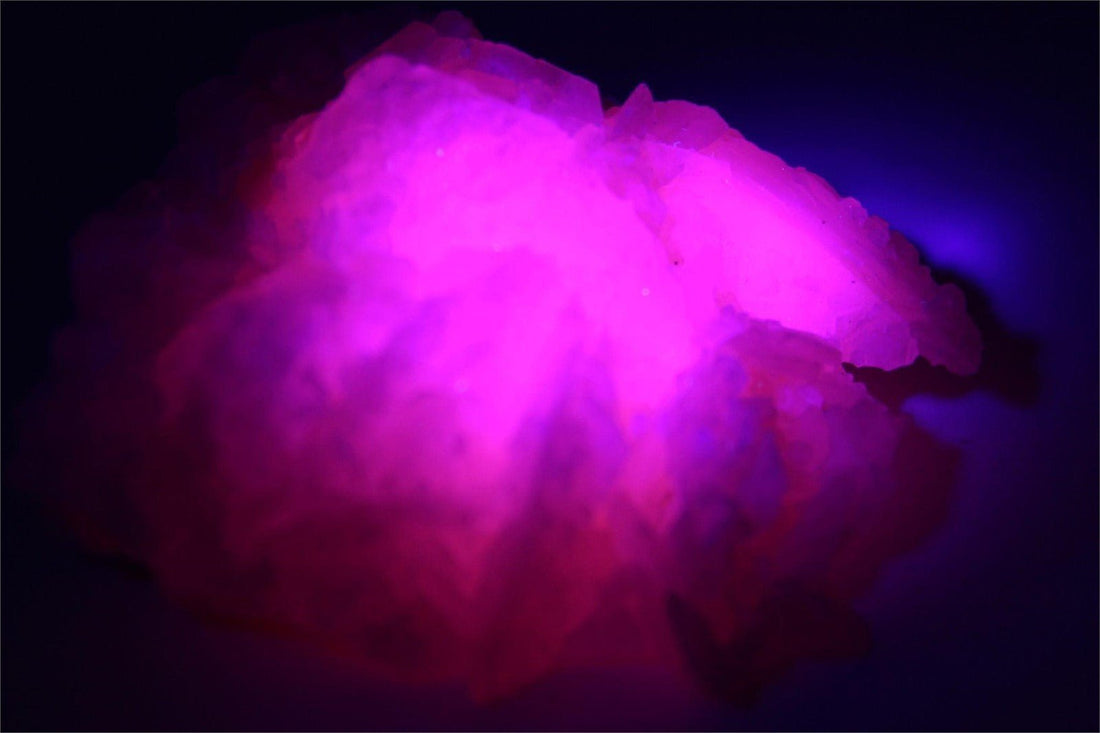
Why Some Crystals Fluoresce
Share
Some crystals glow with magical color under blacklight — but what causes this striking effect? From rare-earth elements to radiation and crystal defects, fluorescence is one of the most fascinating phenomena in mineral science. Here's how it works — and what makes certain crystals light up the room.
What Is Fluorescence?
Fluorescence is the emission of visible light by a substance that has absorbed ultraviolet (UV) or other high-energy light. In simpler terms: the crystal absorbs invisible UV light and immediately re-emits it as color we can see — like blue, green, yellow, or purple.
The effect is only visible while the UV light is shining — once it’s removed, the glow stops.
Why Do Some Crystals Fluoresce?
Fluorescence in minerals is caused by tiny impurities, known as activators, within the crystal structure. These activators absorb UV energy and emit it at lower, visible wavelengths.
- 🔬 Common activators: manganese, uranium, lead, rare earth elements (like europium or cerium)
- ⚛️ Crystal defects: Even subtle irregularities in the atomic lattice can create fluorescent response
- 🌍 Geological setting: Some localities naturally expose crystals to low levels of radiation that increase fluorescence
Common Fluorescent Crystals
- Fluorite: Can glow blue, green, violet, or cream. Famous from Rogerley Mine (UK), XHL Mine (China), Illinois (USA).
- Calcite: Red, pink, orange, or white — especially from Mexico and New Jersey.
- Willemite: Bright green under shortwave UV. Often found with franklinite and calcite in Franklin, NJ.
- Scheelite: Pale blue or whitish-blue. Found in tungsten-rich environments.
- Hackmanite: Fluoresces violet or pink and also exhibits tenebrescence (changes color in sunlight).
- Petroleum-Included Fluorite: Oil-filled inclusions glow yellow-blue, especially in specimens from Pakistan and China.
Types of UV Light Used
Not all crystals respond to the same kind of UV light. Collectors use:
- Longwave UV (LW): 365 nm — what most blacklights emit
- Shortwave UV (SW): 254 nm — often used to reveal hidden fluorescence in minerals like willemite or scheelite
Some crystals fluoresce only under one type — others show dramatically different colors depending on the light source.
Fluorescence vs. Phosphorescence vs. Tenebrescence
- ✨ Fluorescence: Only glows while UV light is on
- 🌟 Phosphorescence: Continues to glow for seconds or minutes after the light is turned off (e.g., some calcites)
- 🔄 Tenebrescence: Changes color temporarily after UV exposure (e.g., hackmanite)
What Fluorescence Means for Collectors
Fluorescent minerals add a surprise layer of value — a secret glow beneath the surface. For collectors, they offer:
- 🔎 A way to verify localities or authenticity
- 📷 Unique opportunities for UV photography
- 🧠 Educational insight into mineral chemistry
- 💫 Simply — they’re mesmerizing!
What It Means in Metaphysical Work
Fluorescent stones are often used in shadow work, lunar rituals, or intuition strengthening. Practitioners view their hidden glow as symbolic of inner truth, revelation, or unconscious energy.
Popular uses include:
- 🌑 Fluorescent fluorite in third-eye meditations
- 🕯️ Hackmanite for energetic transformation
- 🌌 UV grids for full/new moon work
Legacy’s Commitment to Natural Glow
At Legacy Crystals and Minerals, all of our fluorescent specimens are 100% natural — no dyes, coatings, or UV-reactive fakes. We test each piece under both longwave and shortwave UV and note fluorescence levels in our listings when present.
Final Thoughts: Hidden Light Beneath the Surface
Crystals that fluoresce remind us there’s always more than meets the eye. Whether you're collecting for science, energy work, or aesthetic wonder — fluorescent minerals connect you to a deeper layer of light, chemistry, and beauty.



